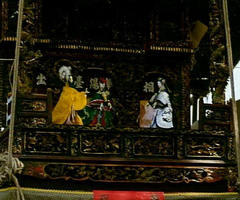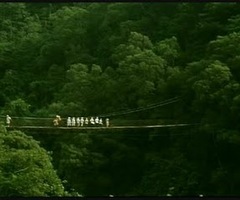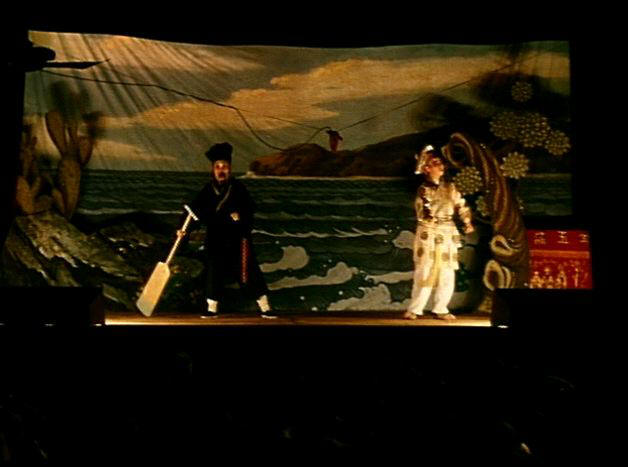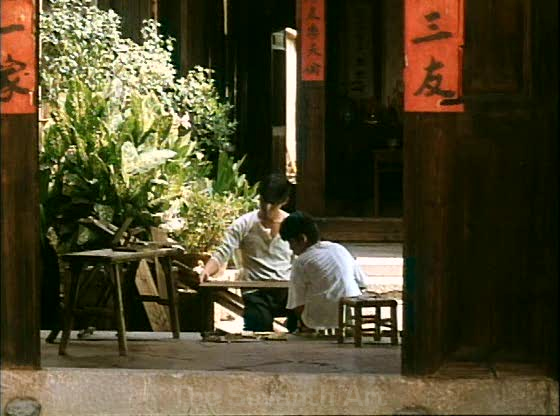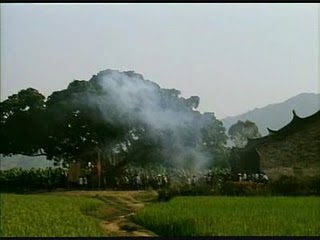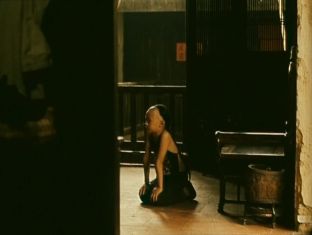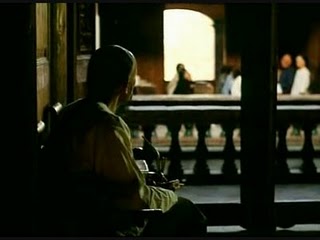From the Chicago Reader (December 3, 1993). — J.R.
THE PUPPET MASTER **** (Masterpiece)
Directed by Hou Hsiao-hsien
Written by Wu Nien-jen, Chu Tien-wen, and Li Tien-lu
With Li Tien-lu, Lin Chung, Cheng Kuei-chung, Cho Ju-wei, Hung Liu, and Bai Ming-hwa
Let’s start with three central and related facts, the first about Taiwan, the second about Taiwanese cinema, and the third about us. (1) Until six years ago, Taiwan spent this whole century under martial law, and over three previous centuries it suffered from nearly continuous occupation — by the Dutch in the 17th century and the Manchus in the 17th, 18th, and 19th centuries. In 1895 it was ceded to Japan as one of the spoils of the Sino-Japanese war, and it remained a Japanese colony for the next half century, until the Japanese surrender at the end of World War II. At this point mainland China took control; but four years later, when the communists seized the mainland, the deposed Kuomintang, led by Chiang Kai-shek, shifted their base to Taiwan — claiming that their rule was only temporary, until they could wrest the mainland back from the communists. But as it turned out they remained in power until 1987, when Taiwan finally became a democracy. Economically flourishing today, with a population of over 20 million, Taiwan is a country with a very strong sense of the future but, as a result of its fractured history, a confused and fragmented sense of its past. (2) Until four years ago, every Taiwanese movie without exception had postsynchronized Mandarin dialogue. (It’s cheaper to shoot without sound and this standard practice makes it easier to dub Taiwanese pictures into Cantonese and other regional Chinese dialects; for the same reason, virtually all Taiwanese films are subtitled in Chinese so that the dialects used won’t restrict understanding by other regions.) But director Hou Hsiao-hsien eliminated this practice in his City of Sadness (1989) because he wanted to preserve the idiosyncratic delivery and Taiwanese dialect of one of the actors, Li Tien-lu — an 80-year-old puppet master and former stage performer who had already played the parts of grandfathers in two of Hou’s features, Dust in the Wind (1986) and Daughter of the Nile (1987). Although Taiwanese accents had previously been heard in Taiwanese films, critic Ted Shen informs me that they were mainly used for comic purposes (as southern accents sometimes are in American films). But Hou employed the regional accent of Hualien, the city in southern Taiwan where he grew up, straightforwardly in his autobiographical A Time to Live and a Time to Die (1985). Thus he has not only introduced the realism of direct sound recording to Taiwanese cinema but also made Taiwanese accents more prominent and important in Taiwanese filmmaking.
(3) No film by Hou Hsiao-hsien, the greatest of all Taiwanese filmmakers, has ever had a U.S. distributor. Talking about Hou’s films isn’t easy in a country as cheerfully indifferent to the rest of the world as ours — a country so shamelessly ethnocentric that the worst, most compromised, and least interesting film of John Woo gets 50 times more press coverage than his others simply because it was made here and not in Hong Kong, and a country so juvenile that a director like Woo, who makes fantasies for 11-year-old boys about masses of people getting sprayed with bullets, receives 50 times more attention, even in publications for grown-ups, than a director like Hou, who makes realistic movies for grown-ups about the way people live. (It may also be relevant that the United States hasn’t recognized Taiwan diplomatically since 1979, when it began recognizing mainland China; according to the existing diplomatic rules, it can’t recognize both.) I can’t count myself entirely blameless in this process of neglect. The last time the Film Center’s Barbara Scharres brought a new Hou film to town was in June 1990, when City of Sadness was shown twice. It’s probably Hou’s most difficult film, and though I made it a Critic’s Choice the week it was shown and the number-two movie on my ten-best list that year (after Jane Campion’s Sweetie), I was too intimidated by it and too fearful of misdescribing it to write about it at any length. At the time there was some talk about it getting a U.S. distributor, and I figured I would wait to write about it when the film returned to Chicago. In fact it never did get distribution, and its second local engagement, again at the Film Center, will be next Sunday and Thursday, December 12 and 16.
In some ways I like Hou’s remarkable and exquisitely beautiful The Puppet Master, about the life of Li Tien-lu, even more — certainly more than Jane Campion’s immensely popular The Piano, an exciting and beautiful enough fantasy in its own right. And Hou’s philosophical look at identity and the nature of freedom, both personal and cultural, will be showing at the Film Center three times this week, on Saturday, Sunday, and Monday. Part of a projected trilogy by Hou called “The Three Tragedies,” about Taiwan in the 20th century, The Puppet Master covers 36 years, from the birth of Li Tien-lu in 1909, 14 years after Japanese takeover, to the end of World War II. City of Sadness, the first part completed, covers the four years between the end of World War II and the retreat of the Kuomintang to Taiwan in 1949, when Taipei was declared the “temporary” capital of the Republic of China. Still to be made is A Man Named Putao Tailang [2011 note: subsequently released as Good Men Good Women], which will cover 40-some additional years of Taiwanese history, from the 50s to the present. It’s often been said that American identity is something of an existential problem because of our melting-pot origins; and being American often means not only reflecting your origins but also, to a great extent, not reflecting your origins. But as a country with an existential identity crisis, Taiwan has ours beat in spades. Significantly, all the statements I’ve read by Hou about this film relate to Chinese identity, not Taiwanese identity. (Example: “The Puppet Master perhaps represents the Chinese people’s attitude towards life. It is in fact Li Tien-lu’s attitude towards life, and it is also mine.”) If you write a letter to someone in Taiwan, you address it “Taiwan, Republic of China.” And even if you manage to separate Taiwanese art and culture from Chinese art and culture (no easy matter), it’s still necessary to address the influence of Japanese art and culture: the streets of Taipei are full of examples of Japanese architecture, and the older residents of the island, like Li Tien-lu, still speak Japanese as well as Chinese. The degree to which Chinese and Japanese forces and influences affect what “Taiwanese” means on every level, at every moment, is only one of the film’s thematic strands, but it’s a central one. That concern also relates to the meaning and importance of Taiwanese accents, especially in light of the fact that, after 1949, the Kuomintang outlawed Taiwanese dialects in such institutional settings as schools and the government. By the same token, Taiwanese history is a relatively new subject — prior to 1987, it was effectively a forbidden subject — and Hou’s ambitious effort to uncover, even create, that history has the force of a psychic necessity. “If you don’t understand your home,” he has said, “you can’t love it.” Much as Taiwanese language, culture, and history have been outlawed, the art of Li Tien-lu was subject to repression, coercion, and alteration. In 1937, when another Sino-Japanese war broke out and the Japanese banned all performances of traditional Chinese theater, he found work as a traveling actor; four years later he was obliged to join the Japanese Puppet Propaganda Group. (One of the most fascinating puppet performances in the film is wartime agitprop, complete with villainous American and English soldiers.) As in Farewell My Concubine, the way political upheavals shape, and often limit, individual destinies is clearly important. Yet here this is not simply a message to be delivered, as it sometimes is in Chen Kaige’s relatively bombastic epic, but rather a zone of thought Hou enters, contemplates, queries, tests, and endlessly explores.
This inquiry may have had some bearing on the film’s title. As a puppet master who learned his craft from his father, began working as a stage assistant at 9, and gave his first puppet performance at 14, Li figures in some ways as an artist-god; yet in other respects he’s often a puppet himself — a fact that his own narration clearly acknowledges. Another part of this inquiry has to do with the relation of Li’s family to the state, but no sooner is this question broached in The Puppet Master than it becomes vexing, almost impenetrable: given the history of Taiwan and the ambiguities of Taiwanese identity, one can only ask, What is a Taiwanese family, then or now? And what is — or could be — a Taiwanese state? Eschewing close-ups, The Puppet Master consists exclusively of medium and long shots — most of them extended takes from fixed camera positions — and adopts three forms of story telling: re-creating scenes from the childhood, adolescence, and early adult life of Li Tien-lu, with Li himself occasionally narrating the events offscreen; showing Li today in many of the same locations, recounting his past directly to the camera; and showing us extended scenes from the kinds of theater in which Li worked, both as puppet master and as a live performer in Chinese opera and vaudeville. The most immediately accessible parts of the film are usually the shots showing Li himself — largely because he talks about his past with enormous charm and directness, but also because he nearly always appears at a particular location shortly after it’s been introduced dramatically. The sudden shifting of gears between “fictional” and “nonfictional” and between past and present, with Li meanwhile shifting from offscreen to on-screen narration, is usually accompanied by some narrative clarification that provides an illuminating change in our perspective. The only rough parallel I can think of in Hollywood filmmaking is the use of real-life “witnesses” in Warren Beatty’s Reds; but here it’s as if John Reed himself, not people remembering him, suddenly appeared on-screen. Emotions are rarely absent from these scenes with Li, though they’re sometimes delayed because his exposition reveals the story gradually. A characteristic example occurs quite late in the film and involves the death of Li’s youngest son, when he and his family were living in a “coffin shop” in a small village to which they’d been evacuated. We move from a shot of Li’s wife crying in her bedroom (we don’t know why) to a long take in which we hear and observe from a distance some hammering in a courtyard, accompanied by Li’s offscreen narration; only after we cut to Li in the same setting, continuing to talk, do we learn of his son’s death, its tragic circumstances, and the fact that Li had to nail the coffin together himself — which suddenly accounts for the hammering we’ve been hearing and seeing.
By contrast, the long stretches of theater and puppet-theater performance are usually more abstract and intellectual in effect, in part because we can’t always understand the action. But the performances themselves are invariably mesmerizing and beautiful. I especially love the rapid waving of a blue and white flag during puppet performances to signify a lake or river. Understandably, given the film’s endlessly searching questions about freedom and identity, Hou’s choices in this elliptical narrative are often both unexpected and telling. As Godfrey Cheshire points out in an extended article about Hou in the November-December Film Comment, we see much more and learn much more of Lei-tzu, a prostitute Li becomes involved with during the war, than we do of his wife (though, curiously enough, the actress playing Lei-tzu, unlike the wife, is not identified in press materials). What we learn about Lei-tzu is also highly selective: one of Li’s lengthiest on-screen narratives — describing his first impressions of Lei-tzu when he was an opera performer doubling as an usher — focuses on the expensive cigarettes she was smoking when she entered the theater, one of which she offered to him, in a package decorated with storks. (Later we observe her elaborate method of offering him cigarettes and then lighting them in the brothel where she works, shown as a special kind of love play.) Images also play an important role when Lei-tzu gets some professional photographs taken of herself, and Li (Lin Chung) examines them all, tearing them up one by one until he arrives at the one he likes, which he kisses. Li’s feelings for Lei-tzu seem to follow from his capacity to make free choices about her: deciding to follow her when she leaves the Happy Show Theater, deciding which photograph of her he prefers. The question of Li’s sexual fidelity to Lei-tzu — which she tests when she pretends to go see her sick grandmother and has another prostitute offer to sleep with him while she’s “away” — is never matched by any discussion of his fidelity to his wife. Similarly, we get a detailed account from Li about how he cured a serious lip sore Lei-tzu had, using a grotesque folk remedy involving frogs, but hardly a word about the fate of his wife when she contracted malaria in the coffin shop. I suspect that Hou’s emphasis on Li’s relationship with Lei-tzu comes from the complex weave of choices Li made and obligations he undertook during childhood and adolescence, including an arranged marriage. As the film shows, his mother died of TB when he was only eight (about the time World War I ended), and his father married a former prostitute the following year; it was mainly the stepmother’s bullying that drove Li to puppetry, though the payment for his performances went to his father. Much later, when his grandmother couldn’t get along with his stepmother, he was allowed for the first time to keep the money he made, in exchange for housing and taking care of his grandmother — though his duty to her was compromised when a Japanese police chief required him to perform on the emperor’s birthday and she died during his absence.
Just as the theaters in which Li worked were Chinese and Japanese, Hou clearly draws on the artistic traditions of both these cultures. Because Li did much of his work in remote mountain areas, The Puppet Master is the first Hou film I’ve seen in which landscapes, as opposed to exterior settings, play a substantial role. Traditional Chinese landscape paintings from at least the sixth century onward appear to have exerted a strong influence (though one extraordinarily lit, astonishingly beautiful shot of the sea and clouds suggests Turner), particularly in the minuscule role the human presence has in these towering vistas: one often has to examine the compositions closely before people, roads, paths, and buildings become visible at all. In story-telling terms, some of these shots are confusing because we can’t always tell precisely what the characters are doing. But on a broader level this is surely the point: the specific activities of a few individuals are trifling next to the larger, more enduring shapes and formations.
In terms of cinematic influences, Hou has most often been linked to Yasujiro Ozu, despite the fact that he developed his long-take, stationary-camera style long before he saw his first Ozu picture. In the case of The Puppet Master, I think almost as apt a comparison can be made with another Japanese master, Kenji Mizoguchi–at least if one overlooks Mizoguchi’s camera movements and concentrates on his repetition of the same basic camera angles in the same settings in scenes separated by many years, a formal device that figures powerfully in his Tale of the Late Chrysanthemums (1939). In one of the earliest scenes in The Puppet Master we see Li as a boy being beaten by his mother for stealing calligraphy manuals: he kneels on the floor, then briefly moves out of the frame in an effort to escape her blows; the scene is shot through a doorway at the right, and a wall or room divider fills most of the left side of the screen. (The relative darkness caused by natural lighting here and elsewhere, as well as the camera’s distance from the action, makes the details as indistinct as they are in some of the landscape shots — though I hasten to add that nothing essential is ever kept from our attention.) On later occasions and in other circumstances Hou returns to the same camera angle, and each time there’s a kind of emotional rhyme, a sense in which our memory of the first scene complicates and inflects whatever’s happening. Thus part of Hou’s art is compositional and pictorial — an invitation to look long and hard at certain carefully selected, exquisitely framed scenes and settings — and another part is temporal and musical, an invitation to recall, compare, and synthesize shots widely separated in time. An anecdotal aside: In the early 80s Li Tien-lu toured Arkansas, and at the invitation of its governor performed at the state capital’s fine-arts museum. He met Bill Clinton afterward for dinner, and as a token of good luck presented him with a puppet of Sun Wukong, the monkey king from the classic Chinese novel Journey to the West. Roughly a decade later Clinton was elected president, during the Chinese Year of the Monkey. Even if Hou’s films do eventually acquire a U.S. distributor, I don’t expect them to achieve the kind of audiences, attention, and acclaim accorded to the pictures of John Woo — or those of Jane Campion, for that matter. They don’t serve their meanings up to you on a platter, and they’re too philosophical to ram you in the gut the way that most movies (and their publicity campaigns) are currently expected to. But if a more awesome and affecting new picture than The Puppet Master has turned up in Chicago this year — a movie more relevant to the future of cinema and the 21st century — I haven’t seen it.
Published on 27 Sep 2011 in Featured Texts, Featured Texts, by jrosenbaum

